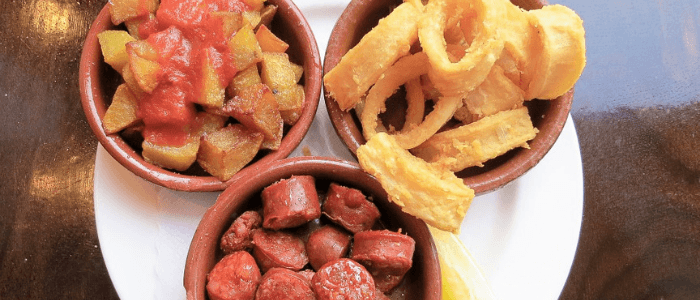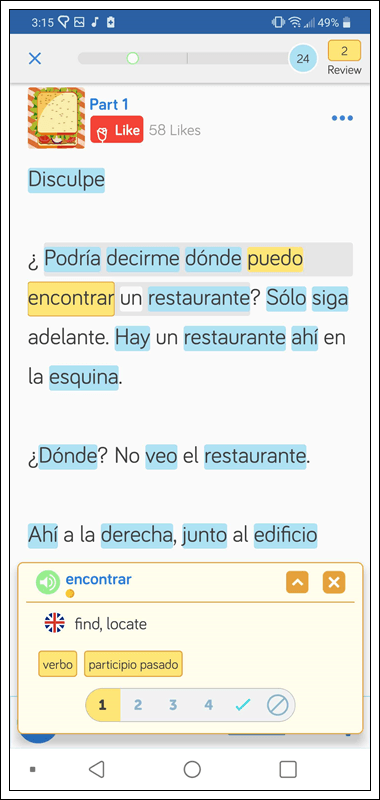Spanish Restaurant Vocabulary for Beginners
What’s more exciting than being on vacation or visiting new places in Spain? Well, the FOOD, of course. But before heading out to eat, it’s important to know how and what to order. Spanish restaurant vocabulary can go a long way. Follow these simple steps to make your next order, a successful one.
Making reservations
Have you ever been kept waiting for a table for more than 45 minutes? Best to avoid those stomach pangs altogether by calling the restaurant you are planning to visit a few hours before you go. Follow this guide to make an over the phone reservation in Spanish.
Recepcionista: “Hola, buenos días, restaurante Los Hermanos habla Lisa, ¿como puedo ayudarle?”
Hostess: “Hello, good morning, this is restaurant Los Hermanos, Lisa speaking, how can I help you?“
Cliente: “Hola Lisa, este es John, llamo para hacer una reservación, ¿Hay una mesa disponible para cuatro personas el próximo martes a las 7 pm?”
Client: “Hello Lisa, this is John, I’m calling to make a reservation. Is there a table for four people next Tuesday at 7pm?”
Recepcionista: “Si señor, tenemos mesas disponibles para cuatro personas, ¿le gustaría reservar ahora?”
Hostess: “Yes sir, we have tables available for four people. Would you like to reserve one now?”
Cliente: “Si me gustaría reservar ahora mismo, por favor.”
Client: “Yes, I would like to reserve one right now, please”
Recepcionista: “Muy bien, la reservación está hecha. Les esperamos el próximo martes”
Hostess: “Yes sir, your reservation is made. We will see you next Tuesday.”
Cliente: “Muchas gracias”
Client: “Thank you so much”
Arriving at the restaurant
Once you arrive at the restaurant, the waiter or waitress will most likely ask you how many people will be joining you for your meal or ask for your name to confirm the reservation.
Here are a few ideas to respond…
Recepcionista “Hola, bienvenidos al restaurant Los Hermanos.”
Hostess: “Hello, welcome to Los Hermanos restaurant”
Cliente: “Hola, soy John, tengo una reservación para cuatro personas.”
Client: “Hello, I’m John, I have a reservation for four people.”
Recepcionista: “Si señor John, su mesa le espera, sígame.”
Hostess: “Yes, Mr. John, your table is waiting for you, follow me.”
Browsing the menu
Once you’re seated and settled at your table, it’s time to check out the menu and order your meal! Here are some general guidelines to find something on the menu that you’ll love.
Appetizers – Las Entradas
Entrees– Los Platos Fuertes
Drinks– Las bebidas
Meat– Carne
Chicken– Pollo
Beef– Res
Pork – Cerdo
Fish– Pescado
Rice– Arroz
Potatoes – Papas
Dessert– Postre
Salad –Ensalada
Soup – Sopa
French fries– Papas Fritas
Pasta- Pastas

Recommendations and ingredients
Still not sure what to order after browsing the menu? It may be good to ask the waiter or waitress what they recommend, or what the most popular menu items are. On the other hand, you may need to clarify a few ingredients in a dish. Either way, here’s the Spanish restaurant vocabulary you’ll need to get the job done.
Cliente: “No sé qué pedir, ¿que me recomiendas?”
Client: “I don’t know what to order, what do you recommend?”
Camarera: “Podría recomendarle el pollo delicioso acompañado por nuestra sopa especial de la casa.”
Waitress: “I recommend the delicious chicken, accompanied by our house special, the soup.”
Cliente: “Perfecto, me gustaría tener eso.”
Client: “Perfect, I’d like to have that.”
Cliente: “Permiso camarera, ¿me puede decir lo que significa esto en el menú?.”
Client: “Excuse me Mrs., can you tell me what this menu item means?.”
Camarera: “Eso significa que la carne esta frito.”
Waitress: “That means that the meat is fried.”
Placing your order
Now that you have chosen a great meal, it’s time to place the order. Check out the following Spanish restaurant vocabulary that will having you enjoying your meal soon.
Camarera: “Están listos para ordenar?”
Waitress: “Are you ready to order?”
Cliente: “Si, Me gustaría ordenar ______”
Client: “Yes, I’d like to order the ______”
Asking for your check
Now that you have had a great meal, it’s time to get back to exploring or relaxing by the pool. Follow these simple steps to ask for the check so that you can be on your way.
Camarera: “Desean algo más?”
Waitress: “Would you like anything else?”
Cliente: “¿Si están amable, podría pasarme la cuenta por favor?”
Client: “Would you be so kind as to bring me the check please?”
Camarera: “Claro que si, en un momento.”
Waitress: “Of course, just one moment.”
Another good phrase to remember would be, “Can I please have (x) ?” which in Spanish is “Puedo tener por favor?” So, if you and your group of friends or family need another chair at your table, you could say “Puedo tener otra silla, por favor?”
Listed below are a few other helpful words to help you feel more confident.
Napkin – La sirvileta
Knife– El cuchillo
Spoon –La cuchara
Fork– El tenedor
Salt– La sal
Pepper – La pimienta
Glass of water –
Un vaso de agua
Juice – El jugo
Chair – La silla
Waiter – El camamero
Waitress– La camaerara
Hostess- El/La recepcionista
Spanish restaurant vocabulary on LingQ
Want even more Spanish restaurant vocabulary to study? LingQ is the best way to learn Spanish because it allows you to study Spanish using content you love. Learn Spanish using YouTube videos, podcasts, Spanish short stories, and much more.
LingQ also comes with thousands of hours of great content already. For example, LingQ’s Eating Out is a great introduction to the Spanish language and you’ll learn to order food and dine out in no time.

Look up new words with ease, using LingQ’s dictionary resources. LingQ also allows you to save new words and review them at a later date using spaced repetition. All of LingQ’s public lessons also come with audio, so you can hear how the words sound naturally.

Also, LingQ is available on mobile. Take your lessons wherever you go and listen to your target language, read your transcripts, and create review flashcards. LingQ’s language learning apps are available for both Android and iOS.
By using content that is 100% in your target language, you’ll learn faster. By using content you love (instead of boring textbooks), you’ll stay motivated. LingQ brings both of these together to help you achieve your language learning goals. Good luck!
***
Erica Lovely discovered her interest for Spanish language and culture in high school. Since then, she has taken her skills across the USA and abroad, volunteering in California and the Dominican Republic. She is currently studying to becoming a Spanish to English medical interpreter.


